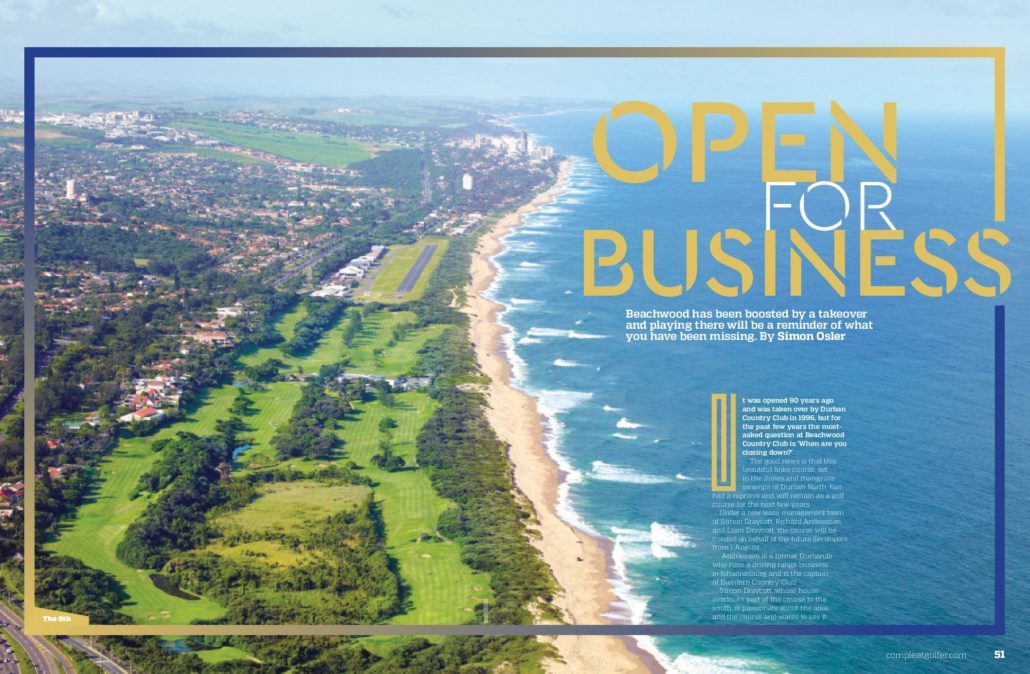Beachwood has been boosted by a takeover and playing there will be a reminder of what you have been missing, writes SIMON OSLER.
It was opened 90 years ago and was taken over by Durban Country Club in 1996, but for the past few years the most asked question at Beachwood Country Club is ‘when are you closing down?’.
The good news is that this beautiful links, course set in the dunes and mangrove swamps of Durban North, has had a reprieve and will remain as a golf course for the next few years.
Under a new lease management team of Simon Draycott, Richard Andriessen and Liam Draycott, the course will be curated on behalf of the future developers from 1 August.
Richard Andriessen is a former Durbanite who runs a driving range business in Johannesburg and is the captain of Dainfern Country Club.
READ: COTM June-July 2020: Jewel of the North
Simon Draycott, whose house overlooks part of the course to the south, is passionate about the area and the course and wants to see it flourish and be an attraction for young families in particular. His son Liam is a sports fan and enthusiastic golfer who is involved in property management and will be the hands-on driver of the team.
The management has attracted new caterers and a Colombo Coffee franchise, with other activities planned to boost social numbers from the local community.
With a ‘soft handover’ under way since 1 July, there is already a more positive and enthusiastic atmosphere about the hub of the course. And since golf has reopened after the Covid-19 lockdown, the course has been far busier than it was at the start of the year.
The course is in pristine condition for winter, and playing well as a pure links course. Despite its lack of length, at just over 6 000m from the tips, Beachwood is a tough challenge with many tight holes, the narrow fairways and deep rough contributing to the downfall of many a decent player.
Throw in the exposure of many holes to the prevailing winds and it becomes a strategic battle against par. Just take a look at the scoreboard at the 2018 KZN Strokeplay Championships which were played in a strong north-easter – four rounds of four-over par would have been good enough to finish inside the top 20. Only five players, three of them internationals, finished below par.
Most of the holes run on a north-south line parallel to the Indian Ocean which is no more than a lob-wedge away from the fairways of the 8th to the 11th holes.
There are lots of bird species on the course, from members of the kingfisher family, to weavers and little bee-eaters, right up to the big boys like the pelicans, woolly-necked storks and herons. But let’s meander around the course at a leisurely pace and look at the challenges.
The opening hole requires a straight drive and is a good indication of what you can expect to face most of the way round. Hitting it with a fade is not recommended – in fact, on this hole a bad hook will probably provide a view of the 1st green from the 10th fairway.
A fairly large green awaits and the paspalum grass is true – pick the right line and the ball will drop. Try to avoid the deepish greenside bunkers on both sides of the green.
The second is one of the few holes that does not run north-south – the 145m par three from an elevated tee is strongly influenced by the wind – and short is not an option. Aim for the bunker at the back of the green as a target – if you come up 10m short of it, you will be in the middle of the green.
Then you come to two back-to-back par-fives. The 3rd hole is much the longer of the two and offers a wider fairway – for most players it will be a three-shotter to reach the large green which has a surprising amount of slope.
ALSO READ: COTM May 2020: Mbombela GC
The 4th has a very narrow tee shot, but if you are long and straight, you might only have an 8-iron to the long and narrow green, which has bunkers on the left and a swale on the right.
Down the slope and up the stairs to the raised tee of the 5th. Look behind you and you will see what is now the Italian Club of Durban. Until the early 1990s this old building was the clubhouse and the tee you are on used to be the opening hole.
The fifth is a risk-and-reward hole for the longer hitters, especially when set up from the forward tee, when the hole is in essence just a long par three. Stay away from the stream down the right-hand side of the fairway and par is an easy score on this hole.
Then walk up the hill to the pulpit tee of the stroke-one 6th hole, the signature hole (see pg 55) of this course, which is widely regarded as one of the great holes on any course in the country and enjoy the views of the ocean behind the 8th and 9th fairways.
The 7th is a par-three of around 145m from an elevated tee box over a small dam to a fairly quick green which has a horseshoe of mangroves around it. The hole is at sea level and protected from the winds – it should result in a routine par. Take a look in the dam as you walk past and spot one of the resident leguaans.
The 8th hole is played across the mangrove swamp and when there is a strong south-westerly wind blowing, some of the big hitters may be tempted to have a dip at the green, which is only about 310m away. But you do need to know the right line to take as the green is not visible from the tee.
The 9th, like the 8th, is a dog-leg left around the mangroves. It’s a hole where prudence is required as the green will not be in reach for anyone, and the fairway is narrow with pitfalls to the left. Be conservative and making your par is a distinct possibility.
You have one more hole left to play before reaching the club-house due to the 10-8 hole split.
The 10th is narrow and usually requires two good blows to reach the green. Being parallel to the first hole, there is space to bail out left but your second shot then has to squeeze through the trees further along the fairway. It is a low-stroking hole and if you have a handicap of four or higher, you might want to consider this to be a short par-five and use your handicap to its advantage. The big green on this hole is often one of the best on the course and it feels like you are walking on thick-pile carpet.
If you are not playing through without a break, now is your chance to grab a bite to eat from an efficient halfway house that offers a variety of good quick breakfasts and a fantastic curry beef sandwich (when available).
You have tackled the toughest part of the course and have a bit more space available to swing the arms on some of the remaining holes.
The 11th is the longest par five with plenty of width to bail out to the left – and when you get to the green, you will realise just how close the ocean is: no more than 50m from the course. It’s played into the prevailing north-easter and it’s often judicious to take an extra club in your approach to the large and undulating green.
The 12th probably plays a full club longer than its 150m, even ignoring the wind. So take an extra club and swing smoothly. Par is usually a good score on this northern-most green on the course before probably your longest walk between holes, some 100m around the top end of the course to reach the 13th tee.
Now, in bingo parlance 13 is known as ‘unlucky for some’. This hole reflects that, as the fairway is no more than a ribbon of grass with trouble left and right off the tee and approaching the green. This is without doubt the toughest hole on the closing eight holes as accuracy is at a premium.
The 14th is similar in shape to 13 but is shorter and has wider fairways. Big hitters can launch their 3-wood all the way to the back of the green and two-putt for birdie at worst. Accuracy off the tee is important for shorter hitters but this hole is rated easiest because everyone should make a par here.
The 15th is the longest of the par-four holes and requires two big blows to reach one of the smaller greens on the course. And it’s into the prevailing north-easterly wind.
ALSO READ: COTM April ’20: Serengeti Estates
The 16th tee box is tucked up in the trees but it is not a long hole. If you can hit a draw – your line is the fairway bunkers down the right – then you will be in the pound seats here. Breathe deep, just two holes to go and you are about to make a 180-degree about-turn back to the clubhouse.
The 17th is a solid par-five with plenty of room to bail out to the left with the tee shot and most players will be thinking about making a three-pointer here. Keep an eye out for the aircraft that are coming in at you on the tee-box, because you are no more than 100m away from the Virginia Airport and right on the approach from the south.
And then on to the final hole. The 18th is a massive par three at 185m. There’s not a lot of room to bail out left or right, but just short of the green is not a bad place to be. With an uphill green, two putts from just short should make for a solid par in front of the clubhouse.
A satisfying round? Definitely. Good at scrambling? You can score well on this course. If you like playing target golf, don’t expect to score well all the time. A conservative approach will serve you and the scorecard well.







